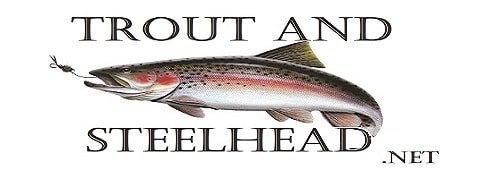Twitching Jigs for Salmon: A Guide for Beginner and Intermediate Anglers
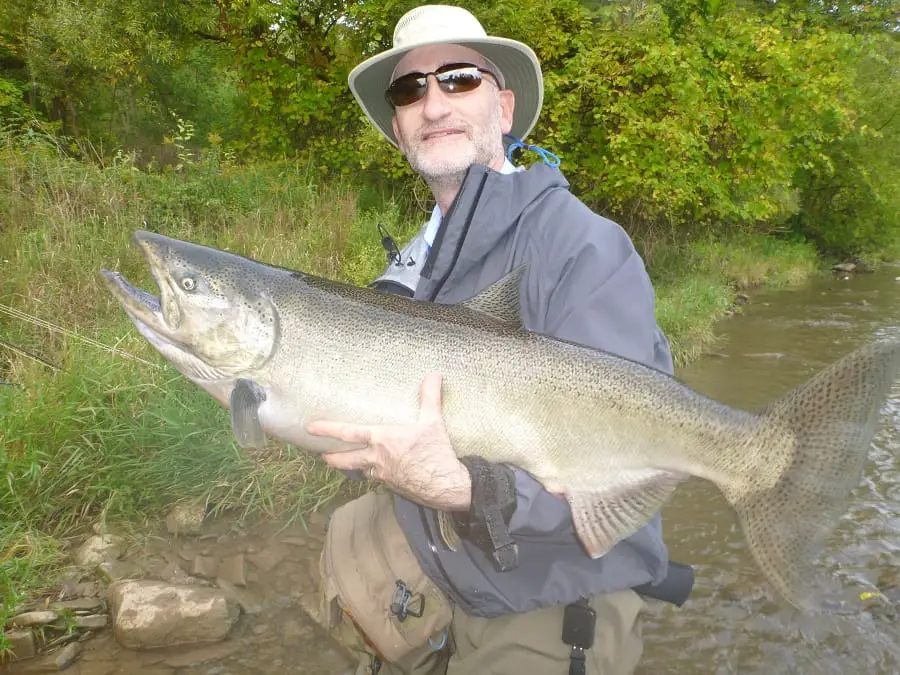
Twitching jigs for salmon is a popular and exciting way to catch salmon in rivers. The reason it is so popular is because it is effective and fun.
If you’ve never tried it, or if you’re looking to up your game, I’ve got some handy tips for you.
Why Twitch Jigs For Salmon?
Twitching for salmon is super easy, and trust me, it’s a ton of fun and can be used anywhere in the river. It’s also a great way to cover water and search for active salmon at any depth or any current speed. Even large deep pools can be fished with twitching jigs.
I’ll even use jigs in pocket water, fishing around boulders, and even in really fast water.
Some anglers will twitch jigs out in the ocean or off the piers at the river mouths.
The most common species for twitching jigs are Coho, Chinook, pink salmon, and chum salmon.
What Is A Twitching Jig
A twitching jig is basically a heavy jig head and hook, with select material around the hook shank and a fairly long tail. The tail is often rabbit fur strips, bucktail, or marabou feathers since these provide a lot of natural movement to the fly.
Adding flash or flashy material can trigger more strikes and produce a lot more fish.
The lead-head jig can be a standard ball jig head, a swim jig head, or even a fish-eye head.
Best Salmon Twitching Jigs
There are a few great twitching jigs that I and other guides find very effective.
If you’re looking to buy twitching jigs, you might be shelling out around 4 to 5 bucks for each one.
Some anglers are into making their own jigs and can cut the cost down to about a buck each.
Best Twitching Jigs
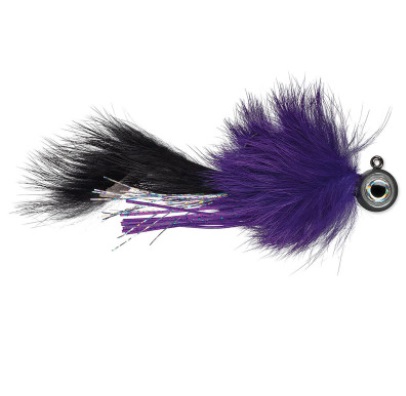
VMC Twitching Jig
There is a lot to like about this twitching jig which is why it’s my favorite.
- Big Eyes
- Sharp wide gap hook
- Rabbit hair and rabbit strip for body thickness, length, and life-like movement.
- Tinsel fibers, flashabou, and living silicone accents
- Lots of great colors
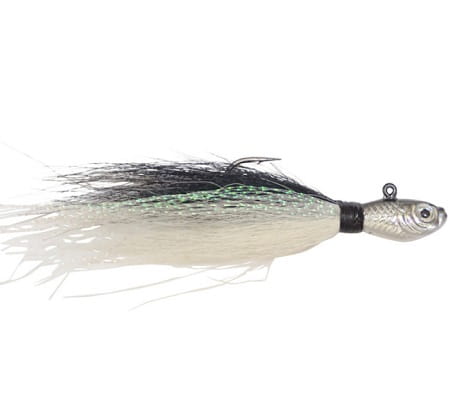
SPRO Bucktail Jig
Another great jig that is one of my favorite twitching jigs for both river and shore.
- made from bucktail for action, body, and length
- Sharp hook with a decent gap
- Lots of great colors and sizes
- Added flash
- Swim head and eye for unique swim action.
- Durable
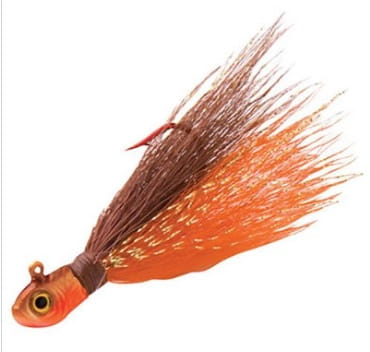
Northland Buck-A-Roo Jig
A twitching jig that is good for steelhead, trout, and salmon fishing.
- Mustad Ultra-Point hooks
- Good thickness and length
- Bucktail with flash for added attraction
- Lots of colors and sizes to choose from
- Large swim head with eyes
- Tip it with a twister tail or paddle tail
Choosing Colors: It’s All About Contrast
Let’s start with colors. Twitching jigs come in a wide range of colors, but salmon tend to prefer a few.
Contrast is king here. You’ll want a jig that has a mixture of colors, like purple, chartreuse, and pink, with maybe some UV flash thrown in.
Contrast actually helps the salmon spot the jig at different depths since some colors pop more in certain water conditions.
Pinks and Chum love the color pink, but chartreuse, black, and orange can also be good
Coho and chinook also like pink and the same bright colors, but they will also go for darker colors like purple and black.
Picking the Right Jig Weight
You’ll find twitching jigs ranging in weight from a quarter ounce to one ounce, with a half once being a good middle-ground size.
The smaller jig heads are perfect for tiny, shallow rivers, while the heavier jigs are your go-to for larger bodies of water and faster currents.
I tend to like my jigs a bit on the heavier side, especially in heavier currents, because you can fish quicker, cover more water, and get into those hidden spots where the big ones like to hang out.
The Jig Hooks
Not all jig heads are created equal, and some of the cheaper jigs can bend on large king salmon.
For the hook, you’ll generally want a high-quality hook, with a chemically sharpened point. You want something robust, like a 3/0 or 4/0 hook, specially designed for salmon fishing.
What Length Of Twitching Jigs For Salmon
When fishing pink salmon and chum salmon, smaller jigs in the 2 to 3-inch range are best.
If you target chinook and coho salmon, jigs in the 3 to 5-inch length are deadly good and will produce the most fish. I will go smaller when fishing for holding fish in small clear pools and bigger in dirtier or faster water.
The Right Twitching Technique
Onto the technique. Imagine you’re trying to make your twitching jig jump or hop through the water. Or even dance in the water.
By twitching your rod upwards and letting it fall naturally. Don’t drop the rod slowly. Think “up, drop!” fast, just like that. This mimics the erratic movement of a real fish, which gets the salmon’s attention.
Stream Positioning: Upstream or Downstream?
For me, I either cast across the river or across and downriver.
However, the type of water you’re fishing in matters because if you’re casting upstream in a heavier current, the current will likely push your jig towards you, so you’ll need to twitch extra fast to keep it from hitting bottom. You do not want to be on the bottom. You want your jig to always be above the salmon head.
If you’re casting downstream, sometimes you can let the current do the work by pulling the jig. Twitch, let it float or drag, and twitch again.
In slow deep pools, casting up or downriver won’t matter as long as you keep your jig off the bottom.
How Many Turns?
Speaking of technique, you might wonder how much you should reel between twitches. This varies with the current, but usually, it’s about a half or a quarter turn on your reel after you let the jig drop. Oh, and remember, you want to keep your jig off the bottom since fish usually don’t look down!
Your Rod Matters, Too
Finally, let’s talk gear. For twitching jigs, you’ll want a rod with a fast, sensitive tip. A fast-action rod bounces back to position quickly.
The last thing you want is to miss a bite because your rod tip is too soft. Make sure your rod is well-balanced, too. You don’t want arm fatigue to ruin your fishing day, right? A 7-foot to 7’6″ inch medium heavy or heavy rod meant for twitching jigs is best.
Check out this article on the best rods and the best twitching rods for salmon.
Types Of Reels For Twitching Jigs For Salmon
A low-profile bait caster or spinning reel outfit is ideal for twitching jigs. The reel you use comes down to preference; however, there are some advantages of using a low-profile bait caster.
Regardless of the reel, you need to make sure your reel has a good line capacity and has a smooth drag system.
Be sure to read our article on the best reels for salmon.
Twitching Jigs For Salmon Q&A
If you have a question or comment about twitching jigs for salmon or want to share your tips, tricks, or favorite twitching jigs, let us know in the comments below.
Tight Lines
Graham
